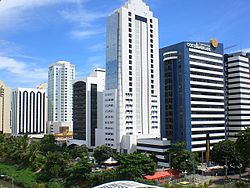Bara ti'Emla
This article is incomplete because it is pending further input from participants, or it is a work-in-progress by one author. Please comment on this article's talk page to share your input, comments and questions. Note: To contribute to this article, you may need to seek help from the author(s) of this page. |
Bara ti'Emla | |
|---|---|
City | |
 Skyline of the Siqabara CBD | |
| Nickname(s): City of a Thousand Spires, The Wall of Emla | |
| Country | Trellin |
| Province | Emla |
| Founded | 472 BC |
| Government | |
| • Prince | Ezrím III Kaliot |
| • Mayor | Temba Sokath |
| Population (2014) | |
| • Urban | 5,849,366 (4th) |
| • Metro | 7,510,842 |
| Demonym | Barikot |
| Time zone | UTC−1 (TCT) |
| Area code | 022 |
Bara ti'Emla (Ahéri, meaning "fortress of Emla"), often known simply as Bara, is a major city in northern Trellin. It is the capital and most populous city in the province of Emla and the fourth most populous city in Trellin, with a population of 5,849,366 and a metropolitan population of seven and a half million. Standing atop the Cliffs of Mlíka, which rise over 150 metres above the Sea of Jajich, it is considered one of the most beautiful cities in Trellin, and its many towers and church steeples have earned it the nickname "City of a Thousand Spires".
The city was founded as the northernmost fortress of the Hyseran Empire, on the north bank of the Lasara river where it plunges over the granite cliffs into the sea below. From its founding to the fall of the Hyser, it remained an unconquered bastion of the north, becoming the heart of the independent Duchy of Emla from 811 until it joined the Trellinese Empire in 1532. During the Trellinese Civil War, between 1892 and 1899, Bara ti'Emla was a firmly Royalist stronghold, and its prince launched his own expeditions in the defence of northern Trellin.
Today Bara ti'Emla is a major economic centre and a hub of IT and pharmaceutical manufacture. It is an important transport link on the country's high speed rail and motorway networks and is served by two airports. In 2015 it hosted a major Astyrian peace negotiation between the ATO and EATA.
History
The city was originally founded as a frontier town of the Hyseran Empire guarding over the coast road from the north. It was at first known simply as Bara, Ahéri for 'fortress', despite lacking any significant defensive walls. The site's strategic value derived from its acropolis, which is only accessible from the south approach, as well as the unassailable granite cliff to the northwest and the river bend to the south and east. Because Bara controlled the last bridge over the Lasara river, it rapidly came to be a major trade focus in the north of the empire.
Immediately prior to the fall of Hysera in 811, Emla seceded from the empire. It remained amiable to the Kingdom of Trellin but came into conflict with Arimathea to the east, fighting wars over the cities of Dargai and Kzint. In 1312, Bara ti'Emla was invaded by Arimathean forces who perpetrated the Bara Massacre, killing hundreds of people inside the city.
Following the marriage of Duchess Moruza to King Tor'qim the Builder, Emla was brought under the Sidereal Crown as a province of Trellin. The provincial capital especially enjoyed Tor'qim's extensive patronage: he built over a dozen Catholic churches and a lavish Thaerine temple in the city and established new schools and courts.
Geography
The northwest coast of Emla is distinguished by sheer granite cliffs, which reach their greatest height around the city of Bara ti'Emla, climbing to 162 m (531 ft) above the Sea of Jajich. Old Bara was built on an acropolis a short distance north of where the Lasara plunges 150 m (490 ft) into the sea.
Economics
Bara ti'Emla's economy is largely based on the production of pharmaceutical and IT products, for which it is the largest centre in Trellin. As well as hosting a number of Astyrian companies, the headquarters of several major domestic pharmaceutical companies are located in the city. The central business district is in the Siqabara district, which is located outside the traditional cultural centre of the acropolis.
Marine freight arrives in Bara ti'Emla at the port of Santbara, 50 km (31 mi) to the northeast, where the cliffs break.
Tourism, both domestic and international, is an important part of the Barikot economy. The city centre receives over three million tourists annually.
Demographics
Culture

Bara ti'Emla is widely hailed as one of the cultural capitals of northern Trellin, famous for its religious and secular architecture and its museums and galleries. From the sixteenth century, the acropolis of Bara has been richly endowed with cultural edifices built under royal sponsorship or by the competing nobility of the province.
Bara is the main operatic centre in Trellin (opera being more popular in Hysera than in Trellin), with a long tradition of prestigious operatic performance in the city. The main venue for opera is Empress Ryarna Theatre, a late nineteenth-century opera house erected under the sponsorship of the Empire of Exponent; the building was seized by the provincial government in 1913, shortly after Trellin entered isolation, and is now a public institution.

